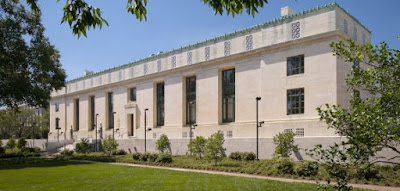Historic National Academy of Science Building - The National Academy of Sciences (NAS) was established in 1863 via a charter signed by President Abraham Lincoln, “to investigate, examine, experiment, and report upon any subject of science or art.” This not-for-profit organization is said to conduct over two hundred studies a year on various subjects. The first study that was undertaken by the organization on April 22, 1863 was the riveting task of measuring the “uniformity of weights, measures, and coins, considered in relation to domestic and international commerce.”
Past and current members have included more than one hundred twenty Nobel Peace Prize winners and famed scientists such as Noam Chomsky (“Father of Modern Linguistics”), Jacques Cousteau (famous oceanographer and explorer), Thomas Edison (noted inventor of 1,093 patented devices including the light bulb), and Albert Einstein. Members of NAS must be voted in and it is considered one of the highest honors of achievement for a scientist to be nominated.
If accepted, scientists are initiated for life. A full listing of past and present members is available on the NAS website and provides a fascinating insight as to the amount of genius that graces the hall of this building on occasion (http://www.nndb.com/org/692/000054530/).
The National Academy of Sciences is housed within a neoclassical building that stands three-stories tall and is constructed of a white New York Dover marble. The building was designed by architect Bertram Grosvenor Goodhue who sadly died just a few days before the building’s unveiling in 1924. If you glance amongst the windows of the building along its front façade you will notice a series of eight-foot low-relief bronze panels.
These were sculpted by Lee Lawrie (who also sculpted the magnificent reredos within St. Thomas Church in New York City) and are said to represent the likes of Aristotle, Galileo, Descartes, and Benjamin Franklin amongst others. The most eye-catching element outside of the National Academy of sciences, however, is a twenty-one foot bronze statue hidden slightly away by a grove of elm and holly trees. The statue dedicated to Albert Einstein was sculpted by Robert Berks and weighs nearly four tons.
 |
| National Academy of Science |
If accepted, scientists are initiated for life. A full listing of past and present members is available on the NAS website and provides a fascinating insight as to the amount of genius that graces the hall of this building on occasion (http://www.nndb.com/org/692/000054530/).
The National Academy of Sciences is housed within a neoclassical building that stands three-stories tall and is constructed of a white New York Dover marble. The building was designed by architect Bertram Grosvenor Goodhue who sadly died just a few days before the building’s unveiling in 1924. If you glance amongst the windows of the building along its front façade you will notice a series of eight-foot low-relief bronze panels.
These were sculpted by Lee Lawrie (who also sculpted the magnificent reredos within St. Thomas Church in New York City) and are said to represent the likes of Aristotle, Galileo, Descartes, and Benjamin Franklin amongst others. The most eye-catching element outside of the National Academy of sciences, however, is a twenty-one foot bronze statue hidden slightly away by a grove of elm and holly trees. The statue dedicated to Albert Einstein was sculpted by Robert Berks and weighs nearly four tons.
- Website: http://www.nasonline.org/
- Address:2101 Constitution Avenue, NW,Washington,DC
- Cost: Free to view






